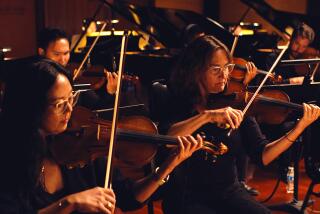An Education Made in Japan : Schools: Students learn U.S. customs, but the emphasis on excelling is clearly Japanese at an academy in Palos Verdes Estates. The demanding curriculum is designed to keep students on par with their counterparts in Tokyo and elsewhere.
- Share via
Coping saw firmly in hand, 11-year-old Dai Oshima knelt over a thin piece of board, vigorously cutting out the pieces of a jigsaw puzzle for his fifth-grade art class.
It was afternoon at the private, nonprofit International Bilingual School in Palos Verdes Estates, time for less rigorous courses like art, health and music. The tough, core subjects like math and science came in the morning.
Fitting the painted pieces together, Dai created a picture of a caped Superman figure flying over tall buildings. He had painted the picture and carefully cut it into a puzzle as part of a class project.
And who was the caped figure?
“Me,” he beamed.
This confident, bright-eyed youngster from Japan is one of 205 students enrolled in a special Japanese academy that teaches primary and junior high school classes just as they are taught in Tokyo or Osaka. The teachers and the curriculum are certified by the Japanese government, the program subsidized in part by Japanese employers.
Located on the old Malaga Cove Intermediate School campus, the academy was founded in 1979 to educate children whose parents were transferred here with Honda, Toyota and other Japanese-based international companies.
Japanese parents, anxious to keep their children competitive, pay from $330 to $430 a month to provide a traditional Japanese education--the only sure way, they say, to give their children a first-rate education. The youngsters also learn American customs, but the emphasis on excelling is clearly Japanese.
“It is not enough for Japanese children to go to an American public school,” said Takatsugu Watanabe, the school’s business manager. “To keep up, they must also go to Saturday school or a cram school, or come here.”
The academy offers a rare look at how Japan educates its children at a time when American schools are getting poor marks.
American students “rank among the lowest in the industrialized world” in math and science, the National Education Goal Report noted in 1991.
By contrast, experts agree that the Japanese school system is highly competitive and “test driven.” Compulsory education ends in the ninth grade, and to continue in school, students must pass rigorous high school entrance exams. The higher the test score, the better the chance of getting into a top school.
“How they do on that test determines what happens during the rest of their life,” said John Hawkins, dean of the UCLA Education Department’s school of international studies. “It is the key to getting into a first- or second-tier public university.”
“That one test has an enormous ripple down effect . . . all the way to nursery school and kindergarten. The whole school curriculum is geared to passing those exams,” Hawkins said.
Given that, Japanese families transferred to the United States fear that their younger children might fall behind if enrolled in American schools, and they routinely seek out special schools like the one in Palos Verdes Estates.
The academy, which leases half of the Malaga Cove campus from the Palos Verdes Peninsula Unified School District, is staffed by 14 full-time and 12 part-time teachers who were trained in Japan and certified by the Japanese education ministry.
A big difference between this private school and the California public schools is the time that students spend in class. The Japanese school year is 210 days long, compared to 180 days in the state’s public schools.
Classes at the academy start at 8:30 each morning; the primary grades stay until 2:30 p.m. and junior high classes get out at 4:30 p.m.
The teaching methods are similar to those in Japan, where federal standards are so strictly followed that a joke is that on any given day, fourth-graders across Japan have their text books open to the same page.
Watanabe agreed, explaining, “The basic idea (in Japan) is that every child, no matter where he or she is born and raised, has the right to the same, basic education . . . everything is uniform, equal in quality.”
Hawkins said that Japanese students coming into the U.S. system are usually two years ahead of their American counterparts in math and science. By the fourth grade, they are into algebra and complex serial equations, he added.
In teacher Yoshihiro Ide’s seventh-grade class recently, the students were studying the development of emotions and social attitudes. The emphasis was on how to control their emotions in different social settings.
First-graders in a nearby class were conducting an assembly. Two students, a boy and a girl, were in charge. Each of 12 students gave a one-minute speech and a report on their daily chores.
At 4:30 p.m., the junior high students all came out of class and took up brooms. They swept the campus clean, an exercise in order and humility, Watanabe explained.
UCLA’s Hawkins is both critical of and, at the same time, impressed by the results of the Japanese system.
“The pressure on these kids is enormous . . . but it works,” he said. “They’re turning out some of the best-educated workers in the world.”
More to Read
Sign up for Essential California
The most important California stories and recommendations in your inbox every morning.
You may occasionally receive promotional content from the Los Angeles Times.










